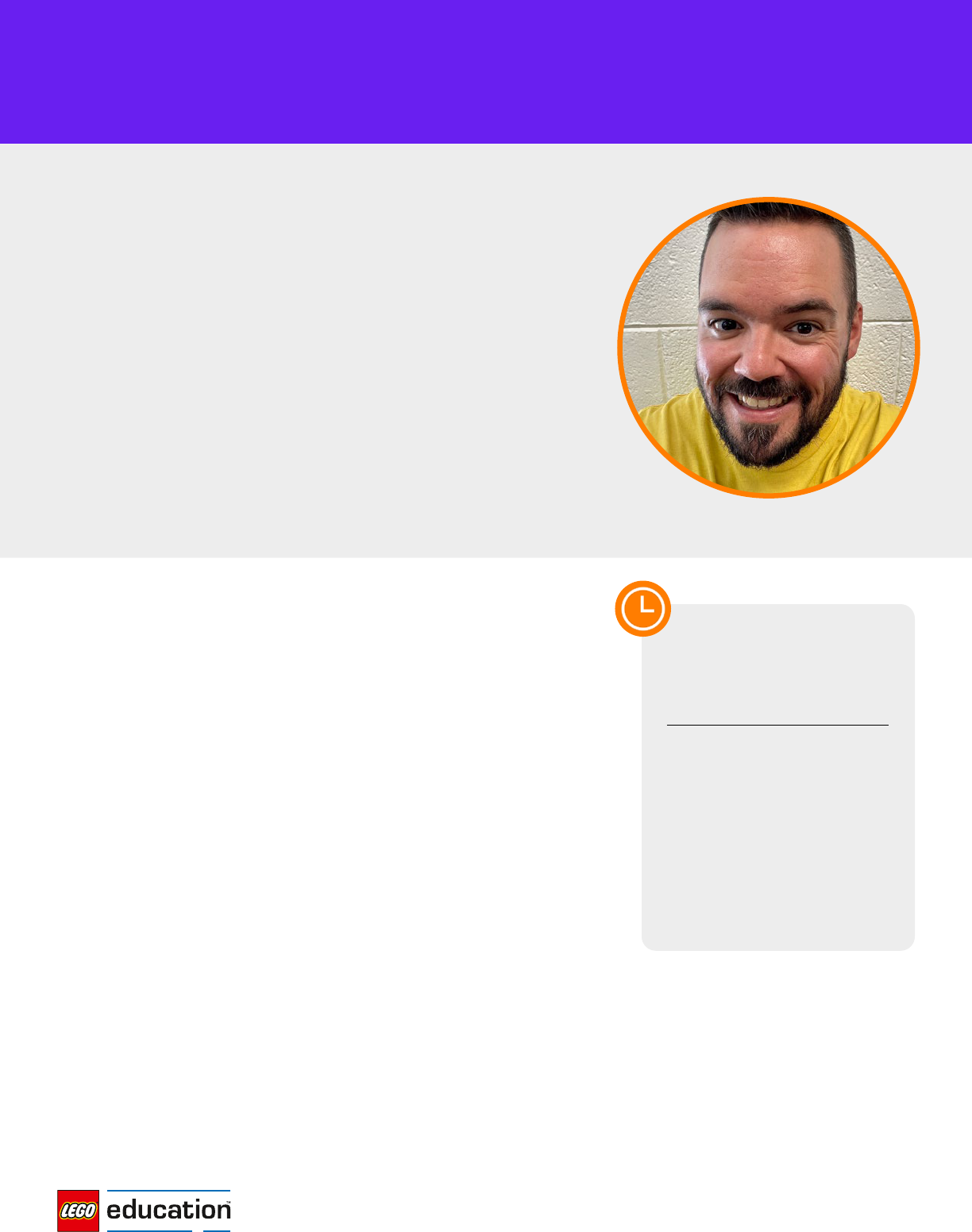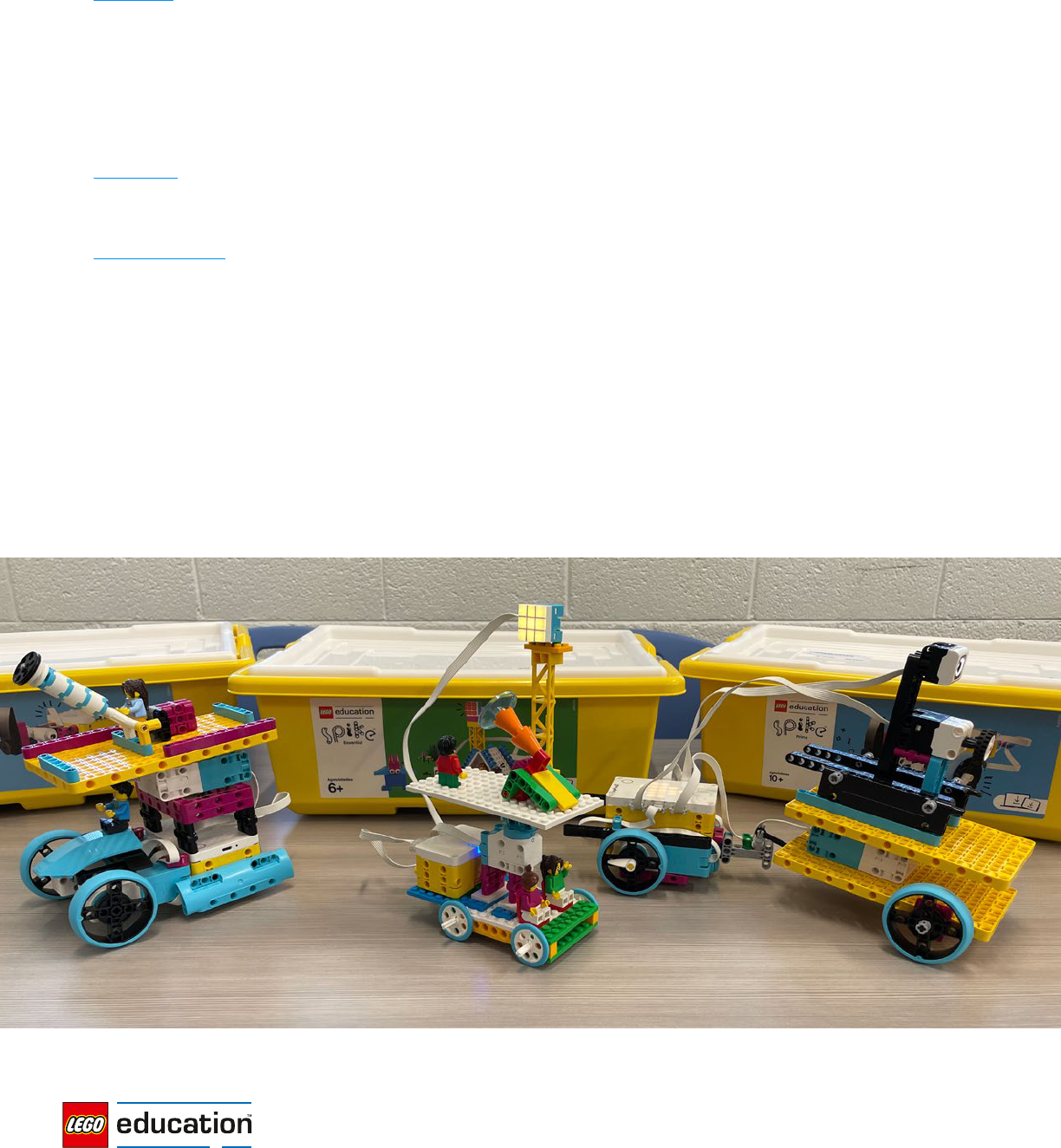
LEGO® Education
Eclipse Collection
Design a Mobile
Observatory
Explore engineering
design challenges when
observing an eclipse

LEGO, the LEGO logo, the Minifigure, and the SPIKE logo are trademarks and/or
copyrights of the LEGO Group. ©2024 The LEGO Group. All rights reserved.
Time
45–90 minutes
STEAM Practices
• Develop and use
models
• Iteratively test and
modify designs
• Meet design constraints
There is a lot of buzz when a total solar eclipse is about to occur!
Whether you are a researcher studying space, a scientist working
for NASA, or a space enthusiast pondering the mysteries of our
universe, there is something exciting for all viewers of a solar
eclipse. In this activity, students will be given the opportunity
to celebrate the total solar eclipse by exploring an engineering
design challenge faced by researchers when observing an
eclipse and its totality. This activity enables students to learn
about or connect what they already know about the Sun, Earth,
and the Moon and what researchers are currently working on in
this area.
This activity is flexible and can easily be adapted for the
grades and subjects you teach. You can use LEGO® bricks, full
LEGO® Education sets, or any materials you already have in the
classroom.
Objectives
• Explore the processes of a solar eclipse and what it can tell us about our universe
• Design and build a prototype of a mobile observatory
Project Overview
Design a Mobile Observatory
Created by Daniel Buhrow
Serving as an educator for ten years, Daniel Buhrow is a 3rd-
5th grade STEAM teacher for the gifted and talented program
in his district in McKinney, Texas. Over the last few years, he
has become an active presenter and instructor for district
professional developments, where he advocates for gifted and
talented students and the instruction his team provides at the
elementary level. Daniel loves to incorporate LEGO® Education
solutions into his curriculum as a LEGO® Education Ambassador
and share his classroom experiences with others. In his current
role, he continues to push the envelope of innovation and
engagement by providing meaningful and impactful lessons to
his future scientists and mathematicians.
LEGO® Education
Eclipse Collection

LEGO, the LEGO logo, the Minifigure, and the SPIKE logo are trademarks and/or
copyrights of the LEGO Group. ©2024 The LEGO Group. All rights reserved.
1. Consider Asking Questions Like
• What is a solar eclipse?
• How do scientists and researchers predict
when solar eclipses will occur and where the
path of totality will be?
• How do researchers and scientists observe
a solar eclipse when the path of totality
changes?
• What are different types of tools and
equipment researchers and scientists use to
observe and study a solar eclipse?
2. Engage Students with the
Following Prompt
Let’s imagine the Sun, the Moon, and Earth are
friends playing hide-and-seek, but they are in
space. Earth is the seeker and trying to find
the Sun and the Moon. The Sun is so bright,
it needs help hiding. A solar eclipse happens
when the Moon moves in front of the Sun,
blocking its light for a little while. Let’s think of
the Sun as a big flashlight in the sky, and the
Moon as your hand. What happens when your
hand goes in front of the flashlight? Do you
see a shadow?
3. Build Background Knowledge
This is a great opportunity for both you and
your students to learn about eclipses. Start
with asking the question: What is an eclipse?
You might explain how this is all because of the
Moon’s revolution around Earth, and Earth’s
revolution around the Sun. There are moments
during the Moon’s orbit around Earth that put
it between us and the Sun. Because of Earth’s
orbit around the Sun, the tilt of Earth’s axis, and
the tilt of the Moon’s orbit can line-up just right
and sometimes the shadow the Moon creates
will land right on Earth, causing a solar eclipse.
4. Connect to Current Events
and Research
Not only are eclipses stunning to see, but they
are also opportunities for research and study.
For example, did you know there are multiple
layers to the Sun? The one that remains visible
during a total solar eclipse is the outermost
part of the atmosphere, called the corona.
The corona can reach extreme temperatures
even hotter than the surface of the Sun itself.
Normally we can’t see the corona because the
Sun’s surface below it is so bright, but during
a total solar eclipse it becomes visible, and
researchers are able to study it. Provide some
relevant examples or have students do their
own research to create even more real-world
connections.
Earth
The MoonThe Sun
Getting Started
LEGO® Education
Eclipse Collection

LEGO, the LEGO logo, the Minifigure, and the SPIKE logo are trademarks and/or
copyrights of the LEGO Group. ©2024 The LEGO Group. All rights reserved.
As a space enthusiast, observer, or researcher,
one challenge is creating a way to view natural
phenomena, like a solar eclipse, on the go! The
path of totality for a solar eclipse only happens
in specific locations that scientists work hard to
analyze and predict. When an eclipse occurs, if you
want the best seat in the house, you may have to
do some traveling!
Scientists will be able to study the eclipse, but they
will need a way to collect data. Can you design a
mobile observatory?
Here are a few things to think about
in your design:
• Protective enclosure that can help protect the
telescope from potential light pollution and
environmental factors like rain, wind, and dust.
• A platform on top of your vehicle or potentially
being pulled by a trailer that can hold a
telescope securely and rotate to move along
with the path of the Sun and the Moon.
• Durability: Your mobile observatory may have
to travel over different terrains. What are some
obstacles you might need to prepare for?
Observing space is all about being prepared for
anything, so we cannot wait to see what you come
up with!
Student Challenge
LEGO® Education
Eclipse Collection

LEGO, the LEGO logo, the Minifigure, and the SPIKE logo are trademarks and/or
copyrights of the LEGO Group. ©2024 The LEGO Group. All rights reserved.
Reflections
Ask students to reflect on their designs:
• What does the model do well?
• How could you improve it?
• What limitations does it have when representing scientific phenomena (scale,
proportion, tilt, etc.)?
Modify and Accommodate
Meet your students where they are. Hands-on, playful learning by nature provides entry
points for students and lends itself to giving opportunities to iterate and ask questions
for those who need more.
Here are a few ideas to consider:
• Simplify or advance the language to explain the concept of a solar eclipse.
• Use visual aids to illustrate the relationship between the Sun, Earth, and the Moon.
• Simplify or increase the design requirements of the mobile observatory design
challenge. Focus on creative and imaginative aspects. For example, have students
build a simple structure that represents a mobile observatory without the emphasis
on specific features. To advance it, throw an extra design constraint into the mix or
add a new barrier to the challenge mid-stream.
• Use visual aids, charts, and diagrams to support understanding. Provide visual step-
by-step instructions.
• Consider grouping based on individual needs. Allow students to work in pairs or
small groups, where they can receive peer support and collaboration.
• Provide opportunities for one-on-one guidance and support during hands-on
activities and discussions.
• Modify materials as needed, such as larger or easier-to-handle bricks.
• Allow extended time for tasks and activities. Break the lesson into shorter segments,
allowing for breaks or adjustments based on individual needs.
Share your students’ builds
with #LEGOeduEclipse
Conclusion
LEGOeducation.com/eclipse

LEGO, the LEGO logo, the Minifigure, and the SPIKE logo are trademarks and/or
copyrights of the LEGO Group. ©2024 The LEGO Group. All rights reserved.
Using LEGO Education Sets
Need inspiration? Explore these lessons to
get started building and try these model
modifications.
• Cave Car: Students can remove the Light
Matrix from the front and add a motor to the
driving base and use the other motor for the
rotating platform. Students can also use a
motor for the rotating platform and the color
matrix to represent the Sun disappearing
behind the Moon.
• Taxi! Taxi!: Students could modify to only use
one motor on the taxi and then use the other
motor for the rotating platform.
• Driving Around: Students can use the simple
driving base from Training Camp 1 as the base
for the mobile observatory.
Other Activities
• Channel your inner storyteller and create a
stop-motion animation or video showing the
events of a solar eclipse. Create the scene
with LEGO bricks or showcase the sequence of
events during a solar eclipse with a storyboard
or creative writing piece.
• Use LEGO bricks or other materials to show
the relationship between the Sun, Earth, and
the Moon.
• Create an observation journal leading up to
and during the solar eclipse. Record data such
as the weather, temperature, and any changes
you may notice in the environment during the
eclipse. (If it is clear skies, look at shadows on
the ground.)
• Create artwork inspired by the solar eclipse.
This could include paintings, drawings, or
sculptures that capture the essence of the
celestial event. Host an art gallery within the
school to showcase your creations.
• Write and illustrate a storybook that explains
the science behind a solar eclipse.
